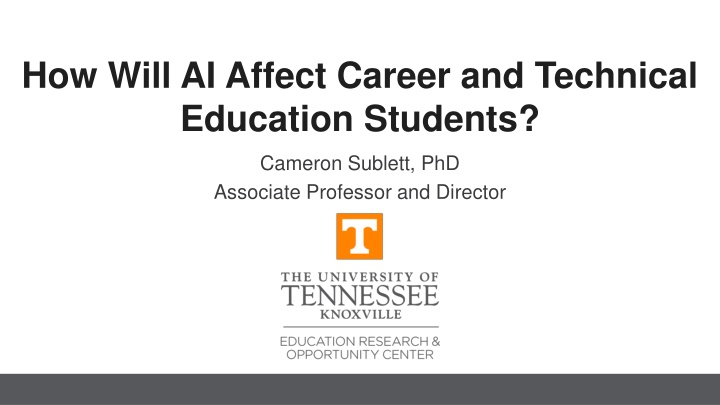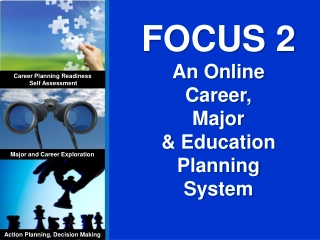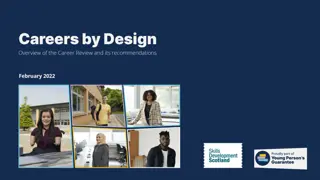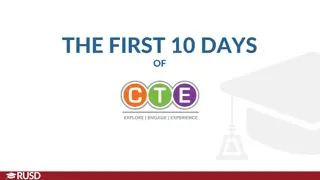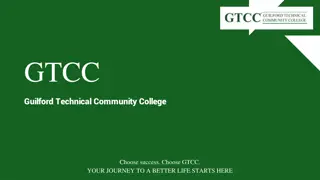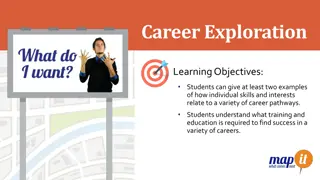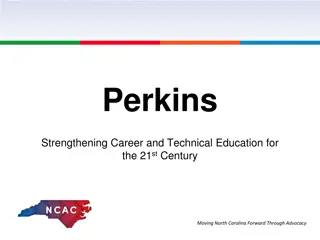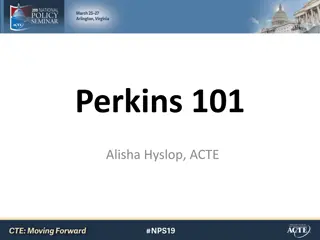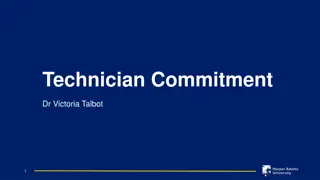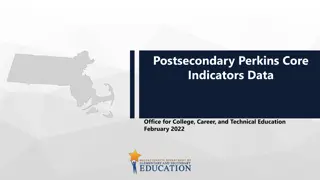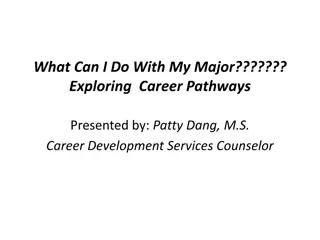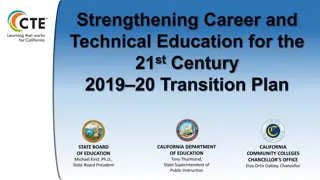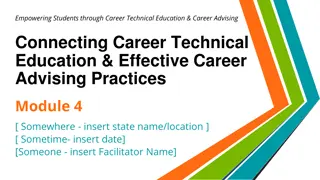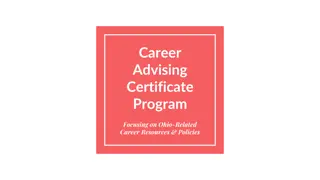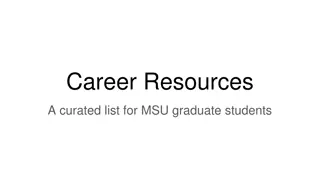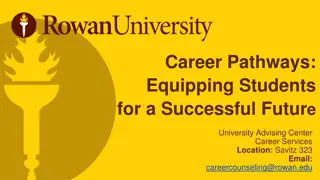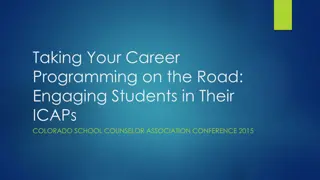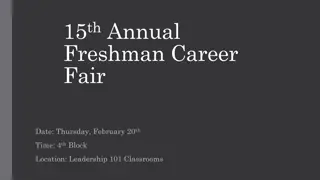Impact of AI on Career and Technical Education Students
Career and Technical Education (CTE) programs are facing potential impacts from AI technology, affecting how students are prepared for specific job fields. Explore the evolution of CTE policy and the challenges and solutions arising from AI integration.
Download Presentation

Please find below an Image/Link to download the presentation.
The content on the website is provided AS IS for your information and personal use only. It may not be sold, licensed, or shared on other websites without obtaining consent from the author.If you encounter any issues during the download, it is possible that the publisher has removed the file from their server.
You are allowed to download the files provided on this website for personal or commercial use, subject to the condition that they are used lawfully. All files are the property of their respective owners.
The content on the website is provided AS IS for your information and personal use only. It may not be sold, licensed, or shared on other websites without obtaining consent from the author.
E N D
Presentation Transcript
How Will AI Affect Career and Technical Education Students? Cameron Sublett, PhD Associate Professor and Director
Overview Definition and Brief History of Career and Technical Education Potential Impacts of AI on CTE Programs and Students Policy and Practice Solutions
What is Career and Technical Education (CTE)? Courses (at the high school level) and programs (at the postsecondary subbaccalaureate level) that focus on the skills and knowledge required for specific jobs or fields of work (NCES, 2023). Practically speaking, CTE equips students with technical skills that are closely tethered to specific workforce applications think carpentry or plumbing Vocational education
What is Career and Technical Education (CTE)? Vocational/CTE Applied Technical know how Specific applications Workforce-specific Academic Theoretical Subject know about Broad applications Workforce-general
What is Career and Technical Education (CTE)? Vocational/CTE Agriculture Computer and Information Sciences Health Sciences Manufacturing Engineering Technologies Academic Liberal Arts Natural Sciences and Mathematics Social Sciences History Psychology
What is Career and Technical Education (CTE)? CTE Career Clusters Arts, A/V Technology & Communications Business Management & Administration Agriculture, Food & Natural Resources Architecture & Construction Education & Training Finance Law, Public Safety, Corrections & Security Government & Public Administration Hospitality & Tourism Information Technology Human Services Health Science Science, Technology, Engineering & Mathematics Transportation, Distribution & Logistics Manufacturing Marketing
Evolution of CTE Policy The Morrill Act of 1862 led the development of land-grant colleges to teach agricultural and mechanical arts to the industrial classes The first federal legislation to devote resources to vocational education as an expression of education policy was the Smith- Hughes Act of 1917 Manpower Development and Training Act of 1962 sought to address high unemployment by retraining individuals with obsolete skills to suit rapidly advancing technology The 1963 Vocational Education Act supported vocational education schools; vocational work-study programs; and research, training, and demonstration programs related to vocational education
Evolution of CTE Policy Carl D. Perkins Vocational Education Act of 1984 (Perkins I) aimed to restore credibility in vocational education through increased program quality and equity Carl D. Perkins Vocational Education and Applied Technology Act of 1990 (Perkins II) built on Perkins 1 by emphasizing the need for integrating academic components into vocational education programs and continuing education through high school Carl D. Perkins Vocational and Technical Education Act of 1998 (Perkins III) continued the basic idea of Perkins 1 and II, with additional focus on special populations and performance data Carl D. Perkins Career and Technical Education Act of 2006 (Perkins IV) emphasized rigorous and relevance, academic integration and workforce alignment Strengthening Career and Technical Education for the 21st Century Act of 2018 (Perkins V) defined CTE concentration, further emphasized workforce alignment through the Comprehensive Local Needs Assessment, employability of student completers, and funding set asides
CTE Today Public and political support for technical education and training is high and rising CTE advocates would assert the evolution of CTE policies overtime have virtually erased the vocational vs academic distinction Existing research suggests contemporary CTE is less stratified along racial, gender, and class lines Shifts towards relevance and rigor and workforce alignment suggest contemporary CTE no longer acts to prep students for dead end careers
Potential Impacts of AI on CTE Students Technology has always been a social and economic disruptor Recent advancements represent something new Advancements in computer science, machine learning and the arrival of big data paved the way for the development of large language models (LLMs) LLMs have the ability to supercharge artificial intelligence (AI) capabilities New AI will undoubtedly fuel workforce automation the questions are how, when, and where
Potential Impacts of AI on CTE Students What we do know: Occupations involving routine cognitive and physical tasks are at greatest risk of automation By contrast, occupations requiring higher levels of education and involving a mix of soft and process skills are at lower risk, overall
Potential Impacts of AI on CTE Students Connection to CTE? The world of work increasingly favors transferrable skills, not technical skills Two-way communication Critical thinking Creativity Problem-solving Contemporary CTE needs to equip student with both I m not convinced we are succeeding What we do know: Occupations involving routine cognitive and physical tasks are at greatest risk of automation By contrast, occupations requiring higher levels of education and involving a mix of soft and process skills are at lower risk, overall
Potential Impacts of AI on CTE Students Existing CTE Career Cluster framework, programs, curriculum and instructional models have the potential to (once again) act as a sorting mechanism Tracking 2.0 Dark history of CTE becomes its future Re-igniting the academic vs vocational divide Unequal opportunity, unequal outcomes Moving students within CTE clusters rich in transferrable skills into positions of advantage Moving students within CTE clusters deficit in transferrable skills into positions of risk
Potential Impacts of AI on CTE Students 1. Average automation risks decrease as education level goes up, largely because jobs requiring bachelor s degrees involve a greater number of transferable skills that are less easy to automate. Keep in mind federal policy largely funds secondary and subbaccalaureate postsecondary CTE providers.
Potential Impacts of AI on CTE Students 2. Second, some CTE career-cluster areas have average automation risks that are low: (ED, IT, STEM). Other CTE career-cluster areas have automation risks that are high: (AC, HOSP, MAN, TRAN)
Potential Impacts of AI on CTE Students 3. Third, the gap between the lowest and highest levels of education is greatest in clusters with the highest aggregate automation risk, which suggests the academic-integration hurdle is higher in these clusters compared with others
Policy and Practice Solutions In theory, CTE students should be better prepared for automation compared to academic students Perkins IV & V Academic integration Comprehensive Local Needs Assessment Apprenticeships and work-based learning Special Populations set-aside The challenge is implementation and the pace of advancement The future is uncertain, but it s clear future learners will need a blend of technical and transferrable education
Shape Icon Description automatically generated with low confidence Icon Description automatically generated Logo, company name Description automatically generated Description automatically generated
